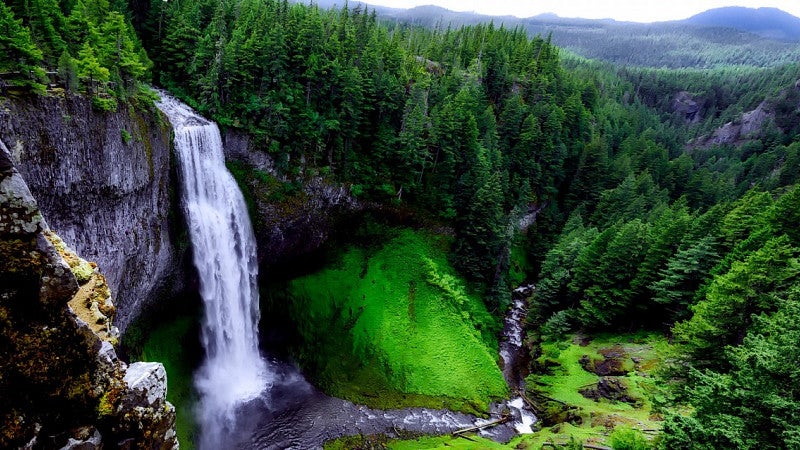Neil Kagan and the Oregon Wilderness Act of 1984: The story of how one Oregon Law alumnus became a catalyst for national policy change.
“We must set ambitious goals for ourselves. They can seem out of reach. The powerful will scoff or stand in the way, or both. We will suffer setbacks. We will wonder whether our goals can ever be achieved. But, trying counts. If we can just keep going, we might just win.”
Ancient mountains covered in towering Douglas Fir trees, mighty rivers roaring, crystal-clear lakes of depths unknown, sounds of wildlife filling the air – this is what Oregon is known for.
The pride that Oregonian’s have in this untamed nature grows in part out of the work of Oregon Law alum Neil Kagan. Thirty-seven years ago, Kagan began a legal fight to preserve Oregon’s most precious natural resources. Following the environmental lawsuits he brought, Congress moved to preserve nearly one million acres of federal land in Oregon through the Oregon Wilderness Act of 1984. Last year marked the 35th anniversary of the act.
Kagan, who graduated in 1981, has spent his entire career taking on some of the biggest environmental cases in the United States.
His 40-year career began the summer before he enrolled at the University of Oregon School of Law. It continued during law school and lasted until shortly after his retirement as a Senior Counsel at the National Wildlife Federation and Adjunct Clinical Assistant Professor and Director of the Environmental Law Clinic at the University of Michigan Law School.
“We must set ambitious goals for ourselves,” said Kagan. “They can seem out of reach. The powerful will scoff or stand in the way, or both. We will suffer setbacks. We will wonder whether our goals can ever be achieved. But, trying counts. If we can just keep going, we might just win.”
And win he has.

Photo Credit: University of Michigan Law School
He won a National Environmental Policy Act lawsuit that stopped the US Army Corps of Engineers from completing the construction of the Elk Creek Dam on Elk Creek, a major tributary of the Wild and Scenic Rogue River, Oregon, preserving wild salmon and steelhead runs.
He won a statewide Clean Water Act (CWA) lawsuit against the US Environmental Protection Agency (EPA), forcing the State of Michigan to reduce mercury pollution in state waters.
Kagan won another statewide CWA lawsuit against the EPA, forcing the State of Ohio to restore water quality in the state’s impaired waters by developing limits on water pollution.
In Wisconsin, by sending a notice of intent to sue, he forced the EPA to stop the State of Wisconsin from undermining rules designed to reduce mercury pollution in state waters.
However, before these victories (and a number of significant others), there were two cases in Oregon. Earth First! v. Block and Oregon Natural Resources Council v. Block, were cases that sent him down the path of defending the environment across the nation.
Following the Dream: Environmental Law at Oregon Law
Kagan arrived at the law school in 1978 with a MS in Entomology from Michigan State University and a BS in Biology from Pennsylvania State University. He arrived the same year Bernard B. Kliks Professor John Bonine established the first environmental law clinic in the United States.
“I had applied to a handful of law schools, and was accepted by most of them, including my first choice at the University of Oregon,” said Kagan. “It was my first choice because it had the best environmental law curriculum. That meshed perfectly with my attraction both to the West and to Oregon, in particular.”
While Kagan was excited to begin his legal journey, he admits that something happened that he never anticipated. He found love. Coincidentally, on his first day of law school.
“At the end of the summer, on August 24,1978, the time came to register for law school,” said Kagan. “That day is the luckiest day of my life because that is the day I met the love of my life. Her name was Elizabeth and she called herself Betty.”
Read more about their relationship in Kagan’s blog Oregon Odysseus
In 1980, Kagan and Reed married. After getting their law degrees, they moved to Roseburg, Oregon. Reed was hired as a Deputy District Attorney for Douglas County. However, Kagan found himself working on divorce cases instead of environmental ones.
“Divorce was something I knew absolutely nothing about,” Kagan recalls. “I spent a lot of time in the law library, educating myself on family law, and I pestered the friendly lawyers in town for advice.”
After almost a year of handling family law and other civil cases, Kagan finally got his opportunity to represent a statewide conservation organization.
“It’s no exaggeration that the wilderness legislation wouldn’t have happened without Oregon Law connections." Neil Kagan
“John Bonine recommended me to the Oregon Natural Resources Council – which is now Oregon Wild - when it was desperate to find a lawyer to represent it,” Kagan said.
Oregon Natural Resources Council (ORNC) was looking for a qualified environmental lawyer to bring litigation in their Bald Mountain Road case, but there was a hitch. They had funds to cover the costs of a new lawsuit, but not enough to pay Kagan. That didn’t stop Kagan, who says that he leapt at the chance to work pro bono for the organization.
“The vision of bringing a case such as this was my reason for going to law school rather than pursuing a career as a biologist,” said Kagan. “I had been preparing myself for this case for eleven years.”
Now, back on track to protect the environment, Kagan worked on two lawsuits for ONRC in 1983.
The first was Earth First! v. Block which was argued before the US District Court for the District of Oregon. As a rookie lawyer, Kagan won the National Environmental Policy Act (NEPA) lawsuit, which forced the US Forest Service to stop building the Bald Mountain Road and logging in the 100,000 acre-plus North Kalmiopsis roadless area within the Siskiyou National Forest in Oregon.
In the second case, Oregon Natural Resources Council v. Block, Kagan filed a statewide NEPA lawsuit against the US Forest Service to stop logging and roadbuilding in all roadless areas in National Forests in Oregon. The case catalyzed the passage of the Oregon Wilderness Act of 1984. After the enactment of the Oregon Wilderness Act, the US District Court entered a final judgment dismissing the Oregon lawsuit as moot.
Kagan considers the case a win because of its tremendous impact on Oregon wildlands, and how it galvanized Congress to preserve more wildlands as wilderness than it would have otherwise. The case spurred seventeen other state wilderness acts and permanently protected more than 8.2 million acres of public lands from logging, mining, road-building, and other destructive development.
Looking back at the enormous effect of the cases, Kagan says that the law school’s role in it all was critical to the outcome. “It’s no exaggeration that the wilderness legislation wouldn’t have happened without Oregon Law connections,” said Kagan.

While Professor Bonine made the initial referral and recommendation, Kagan notes that his wife was vital to the prosecution of the lawsuits. “My work was only possible because of her,” said Kagan. “I was in a position to represent ONRC pro bono only because Betty subsidized my work on her modest income. Sure, she wanted wilderness, but there was another reason for her support, the real reason. She loved me.”
To pay tribute to Betty for the critical role she played in the passage of the Act, Kagan wrote the article Wilderness, Luck and Love: A Memoir and a Tribute published in the Michigan Journal of Environmental and Administrative Law in 2018. Betty, who died from cancer after 15 years of marriage, is who he wants people to remember when they think of his legal legacy.
In an excerpt from his article, Kagan honors his late wife:
“…if you find yourself in the Porcupine Lake Wilderness in Wisconsin, the Bald River Gorge Wilderness in Tennessee, the Paria Canyon Wilderness in Arizona, or in Boulder Creek, the wilderness nearest and dearest to our hearts, please…Remember Betty Reed.”
By Rayna Jackson, School of Law Communications

